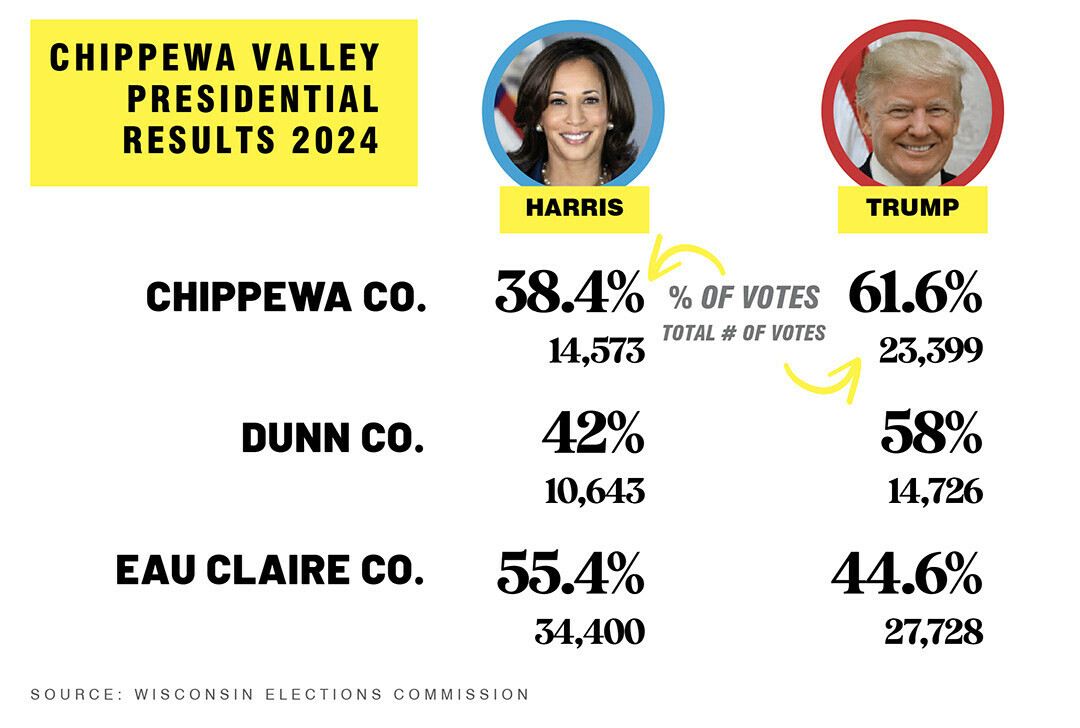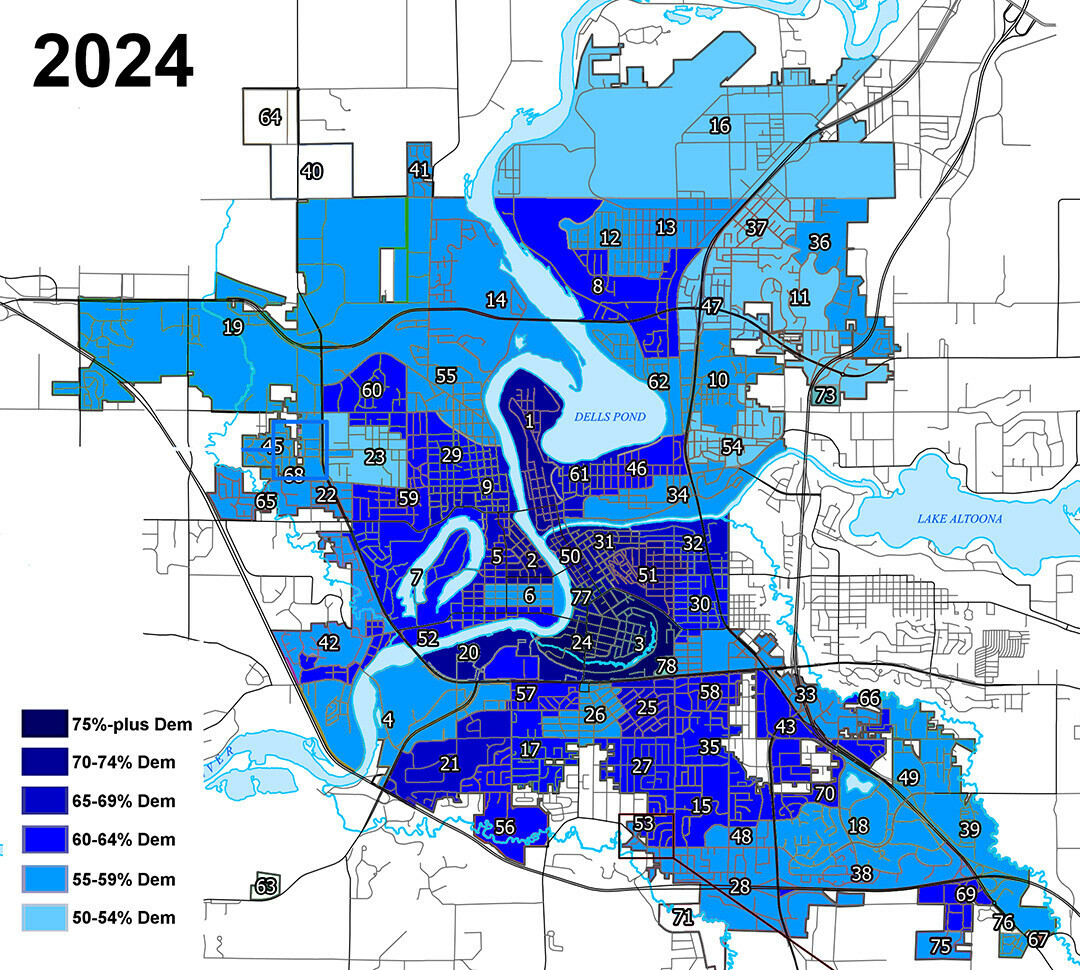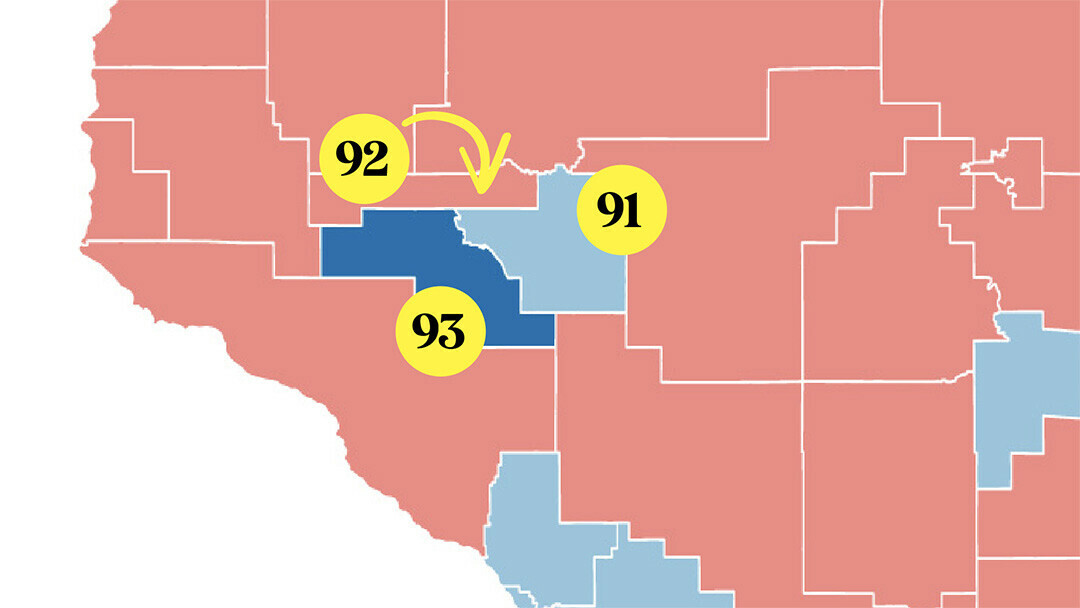
In the wake of a presidential election that featured a Republican candidate finishing on top of the popular vote for the first time since 2004, voting data from western Wisconsin shows trends similar to those seen in other areas of the country. Rural portions moved further to the right – as did one notable part of Eau Claire. Urban and suburban areas remained roughly as Democratic as in recent major elections, but the lack of a leftward shift in these places to balance out GOP rural gains was a major reason Donald Trump gained on Kamala Harris in 2024 compared to Joe Biden in 2020.
Here are some observations from the Chippewa Valley’s performance in the 2024 general election.
1. A Trumpian Youth Vote?
If you were to look at a map of voting wards in Eau Claire and shade them by presidential and gubernatorial election results over the last decade – using blue to signify levels of Democratic support – you would see the deepest hue through the downtown, Third Ward, Eastside Hill, and much student housing. In this election, however, one ward stood out in a lighter shade: the Sixth Ward, broadly in an area bounded by Owen and Randall Parks, between Water and Lake streets, a neighborhood home to home to many off-campus UW-Eau Claire students. After giving Democratic gov. Tony Evers 75% of the vote in 2022 (and Biden 74% in 2020, albeit with somewhat different boundaries), Harris received just shy of 60% here in 2024. This is a swing of nearly 15 percentage points towards the Republican ticket, and syncs with national analysis that younger voters – especially males – were more inclined to vote Republican in this general election than in the recent past. The change could be due to increased support for Trump himself, or could be an indicator of a college-age male shift towards the Republican Party at levels not seen in decades.

2. New Districts Are Swing Districts
In our article from early this year previewing new state legislative district lines, analysis of recent precinct data showed that the three newly drawn Assembly districts in the Eau Claire metro area – the 91st, 92nd, and 93rd – all could qualify as “swing” districts. The 91st was likely to give its Democratic candidate a three-point partisan advantage (D+3) over statewide partisan performance; the 92nd would be R+3; and the 9rd would come out at D+4.
The first actual races in these new districts came close to those numbers. While that partisan advantage uses prior presidential or gubernatorial performance within those districts, the Assembly candidate vote percentages were similar. Democratic incumbent Jodi Emerson won the new iteration of her 91st District over Michelle Magadance Skinner with 51.6% of the vote. Given that Harris won about 49.6% of the two-way vote statewide (not counting third parties), that results in a D+2 number for the 91st District. Republican incumbent Clint Moses took the new 92nd with 53.3%, matching the expected R+3 lean. Democrat Christian Phelps won 52.8% of the vote in the new 93rd District, which now includes the west side of Eau Claire; this translates to a D+3 margin.
If all three run again in 2026, incumbency and familiarity with voters could increase their margins, while the political environment that autumn will be a significant factor in the district competitiveness. The close 2024 margins do increase the likelihood that both parties will engage in most, if not all, of these seats in the near future.

3. A Slow and Steady Rightward Drift
You may have read how Wisconsin’s presidential vote was once again decided by less than 1% – this has been the case for three consecutive elections and in five of the last seven instances. Below that general stability at the state level were shifts in regions of the state.
While the Milwaukee suburbs were among the few parts of the country to move more Democratic since 2020, growing Republican support in the rural communities of western Wisconsin – especially in the Chippewa Valley – helped to offset that difference and keep the statewide vote nearly tied.
Many counties and cities outside the Eau Claire metro areas saw their partisan advantage become more Republican. Some movement was marginal: Compared to 2020, Cadott went from R+11 to R+13, Colfax went from R+2 to R+4, and Bloomer went from R+16 to R+17. Other movement was more dramatic: Eleva jumped from R+6 in 2020 to R+12, nearly a mirror from the 2012 presidential election when it was D+14; while over fours years, Fall Creek moved from R+4 to R+8.
Places adjacent to Eau Claire with more rural and/or working-class characteristics also continued a GOP trend in presidential elections. Lake Hallie went from R+7 in 2020 to R+8, further solidifying a Republican voting nature after being politically-split in the 2000s and ’10s. The Town of Seymour followed that same path, settling in around R+6. For the first time going back to 2004, Chippewa Falls voted to the right of the state in a presidential election, although by less than 0.5%.
There was one exurban counter-example: the Town of Washington. Dating to the 2004 presidential election, this was the first time it voted to the left of the statewide two-party margin (by a slight 0.1%). The township’s demographic similarity to many suburbs could explain the subtle shift towards Democratic support.
2024 marks the final time that Trump will appear on a general election ballot. Given his candidacies’ disruptions to voting patterns, the next two general elections – the 2026 non-presidential midterm, and the 2028 presidential race – should indicate whether the partisan patterns of the last decade will continue locally and nationally, or evolve in multiple directions. For certain, this year’s campaign has reinforced that political analysis will remain of keen interest in the Chippewa Valley.
Online Bonus: A Deep Dive Into the Numbers
Below are results from past election cycles in a number of Chippewa Valley communities. The Democratic and Republican shares of the vote in each year’s most significant election is shown. (In 2024, 2020, 2016, and so on, the most significant race was the presidential election; in the “off years,” such as 2022, 2018, 2014, and so on, the main race was for governor.) The final column, labeled CVPVI – the Chippewa Valley Partisan Voter Index – reflects the partisanship of a given city/county compared to the statewide two-party (Republican and Democratic) result of either a presidential or gubernatorial race. This way, we get a better feel for how these areas are evolving politically.
























